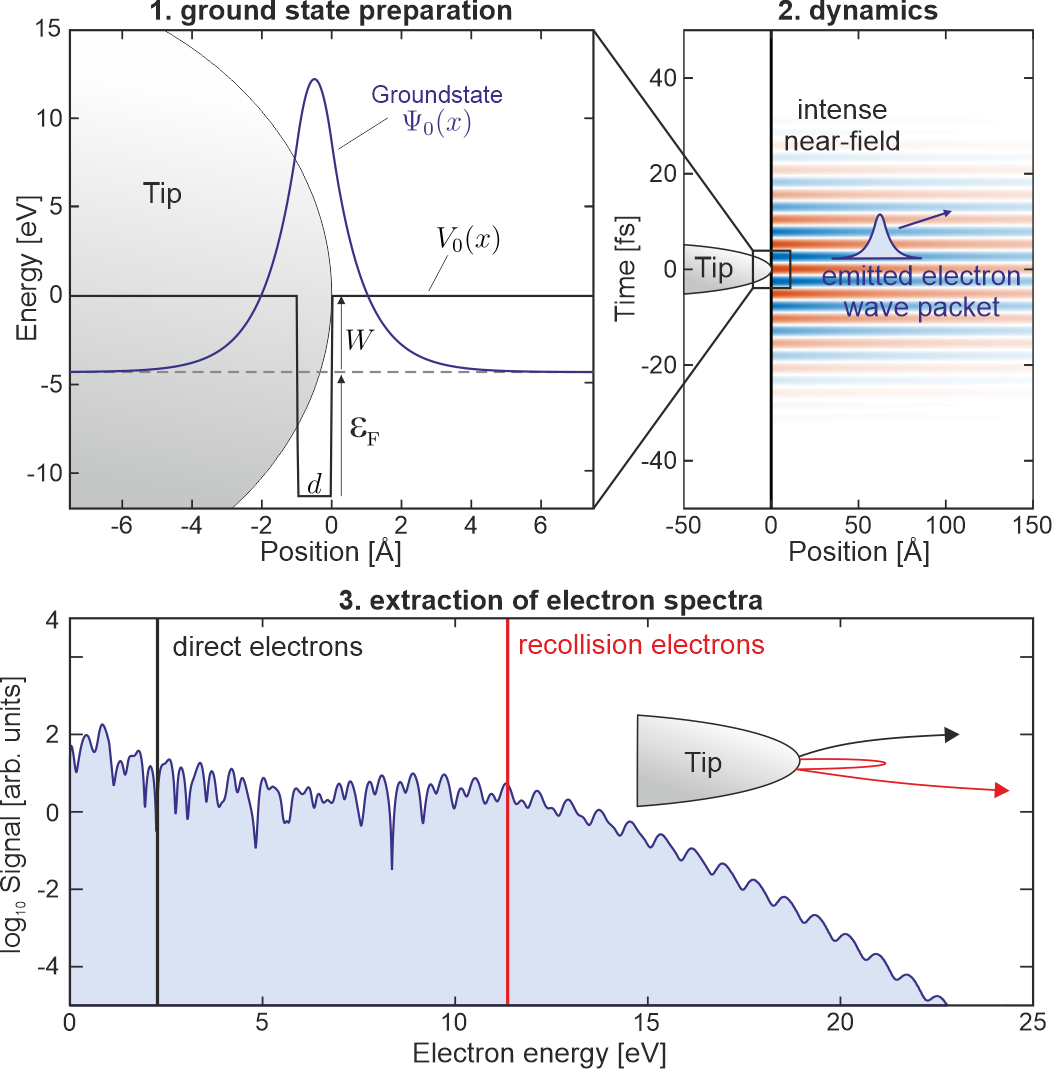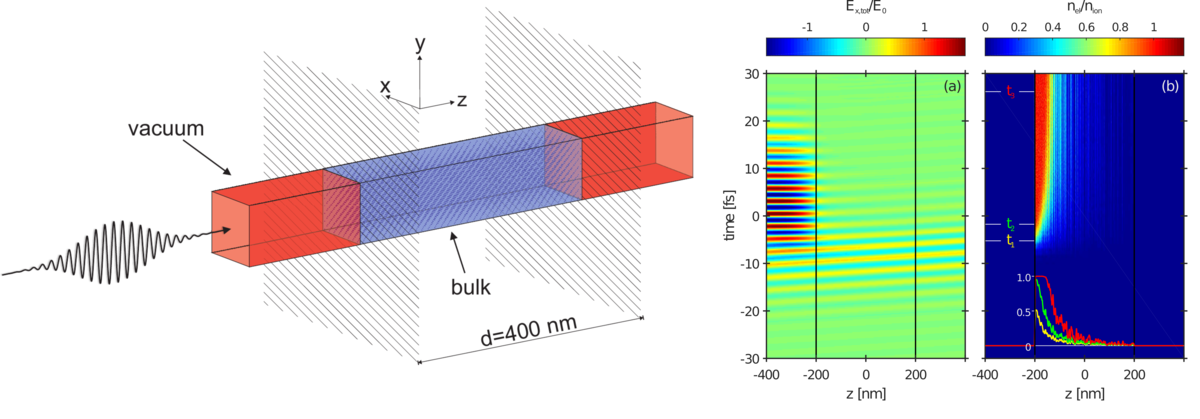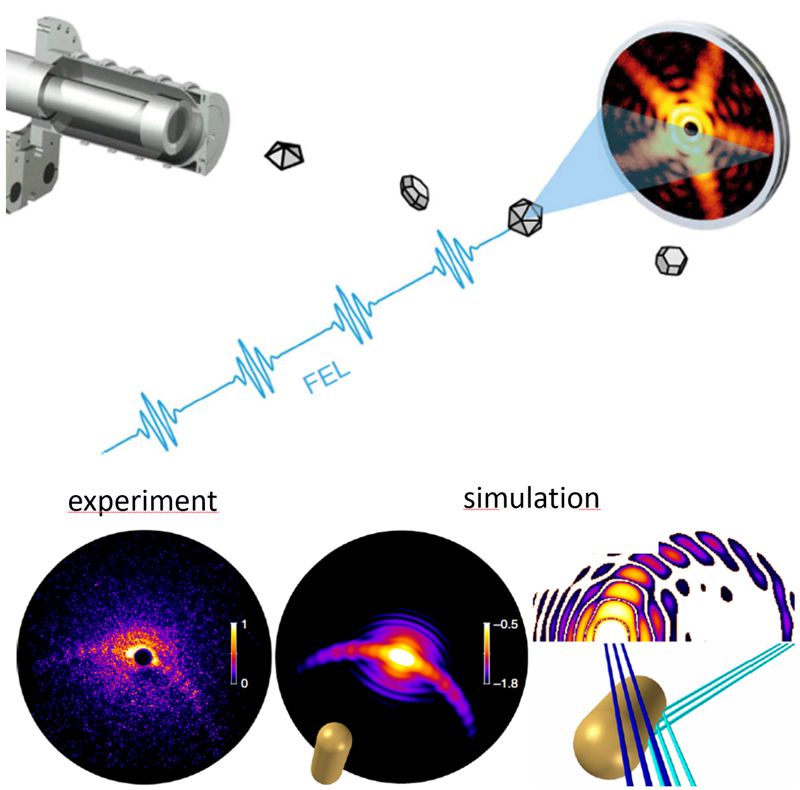| Bachelor Projekte |
|---|
The interaction between a model atom or a nanostructure and an intense laser pulse can be investigated by solving the one-dimensional Schrödinger equation numerically. Typical workflows of these quantum mechanical calculations consist of three steps. First, the computation of the initial groundstate by solving the time-independent Schrödinger equation. Second, propagation of this electron wave packet in the electric field of the laser pulse and third, the extraction of measurable observables like electron energy spectra, emitted high harmonic radiation or ionization probabilities. Possible scenarios to be investigated in your thesis could be laser frequency dependent excitation and ionization of atoms, specific laser field driven electron acceleration processes with connection to the classical three-step model [1], controlled electron emission from nanostructures with particular near-fields (see image) [2] or ionization from combined infrared and short-wavelength laser pulses (“attosecond streaking” and “RABBITT”) [3].
References
- Controlled near-field enhanced electron acceleration from dielectric nanospheres with intense few-cycle laser fields, S. Zherebtsov et al., Nat. Phys. 7, 656 (2011).
- High-order above-threshold photoemission from nanotips controlled with two-color laser fields, L. Seiffert et al., J. Phys. B: At. Mol. Opt. Phys. 51, 134001 (2018).
- Attosecond chronoscopy of electron scattering in dielectric nanoparticles, L. Seiffert et al., Nat. Phys. 13, 766 (2017).
Non-linear pulse propagation
The spatial and temporal evolution of electromagnetic fields in vacuum or in macroscopic media is determined by Maxwell’s equations, which can be solved analytically for a wide range of educationally valuable scenarios. Real world scenarios, however, often require a numerical solution of the problem, especially when considering complex material responses like dispersion, non-linear polarization or even field-driven ionization. These effects lead to important features like harmonic generation, self-steepening or self-phase modulation, which are key to modern laser technology. Within this project you will implement a one-dimensional variant of the “Finite-Differences-Time-Domain” method to solve Maxwell’s equations, including the necessary expansions to account for the mentioned complex responses. The main goal of this project is to study to what extent these nonlinear effects can be controlled by the temporal structure of the applied electromagnetic fields.
References
- Origin of strong-field induced low-order harmonic generation in amorphous solids, Nature Physics 16, 1035 (2020).
- Computational Strong-Field Quantum Dynamics, De Gruyter, ISBN: 978-3-11-041725-8 (2017).
The advent of short-wavelength free-electron lasers such as FLASH, LCLS, or XFEL has enabled novel possibilities to investigate the structure and dynamics of nanosized matter via single-shot coherent diffractive imaging (CDI). The key idea behind this method is the detection of a meaningful scattering image with a single exposure – offering a platform to capture still images of forms of matter that are transient, short-lived or not stable under conditions required for conventional microscopy. Single-shot imaging of nanosystems with XUV light even offers the possibility to capture 3D information in a single shot via the analysis of wide-angle scattering. The aim of this bachelor project is the implementation of a scattering code for wide-angle x-ray imaging (multislice Fourier method) and the analysis of the scattering features for facetted nanostructures, like octahedra or icosahedra, and their evolution with structure parameters like edge sharpness and face curvature. Such analysis will be important to trace structure formation or the temporal dynamics of laser induced melting of free nanoparticles.
References
- D. Rupp et al., Coherent diffractive imaging of single helium nanodroplets with a high harmonic generation source, Nat. Commun. 8, 493 (2017).
- The 3D-architecture of individual free silver nanoparticles captured by X-ray scattering, I. Barke et al., Nat. Commun. 6, 6187 (2015).
The interaction of clusters with intense ultrashort laser pulses show a fundamental differences regarding the ionization mechanisms when switching from infrared pulses to short-wavelength free-electron-laser based XUV (extrem-ultraviolet) radiation. In the infrared regime, ionization is typically initiated by tunnelling or multi-photon ionization with subsequent very efficient laser heating e.g. by inverse bremsstrahlung and resonant collective energy deposition. For XUV-pulses, single photon absorption governs the ionization of the clusters while ponderomotive effects are suppressed. In short, the field-dominated cluster dynamics at optical frequencies becomes photon-dominated in the XUV domain. For both regimes, there are various interesting questions regarding to modelling of the ionization and expanding of the cluster and the possible tracking of the transient nanoplasma evolution in experiment. Pump-probe scenarios offer direct access to the time-dependent nanoplasma dynamics. One option for an interesting bachelor project with close relation to one of our recent FEL experiments is the simulation of XUV-XUV pump probe ionization of rare gas clusters via semi-classical molecular dynamics simulations. To this end, the motion of plasma particles is treated classically while quantum effects like photon-absorption and tunnel ionization are included via by rate equations. The aim of the project is to simulate the delay dependent photoelectron spectra for the comparison with experimental data.
References
- Nanoplasmonic electron acceleration by attosecond-controlled forward rescattering in silver clusters, J. Passig et al., Nat. Commun. 8, 1181 (2017).
- Ionization avalanching in clusters ignited by extreme-ultraviolet driven seed electrons, B. Schütte et al., Phys. Rev. Lett. 116, 033001 (2016).
- Ionization heating in rare-gas clusters under intense XUV laser pulses, M. Arbeiter et al., Phys. Rev. A 82, 013201 (2010).
| Master & Dissertations Projekte |
|---|
Themen für Master- und Promotionsprojekte zu unserer aktuellen Forschung erhalten Sie auf Anfrage.




